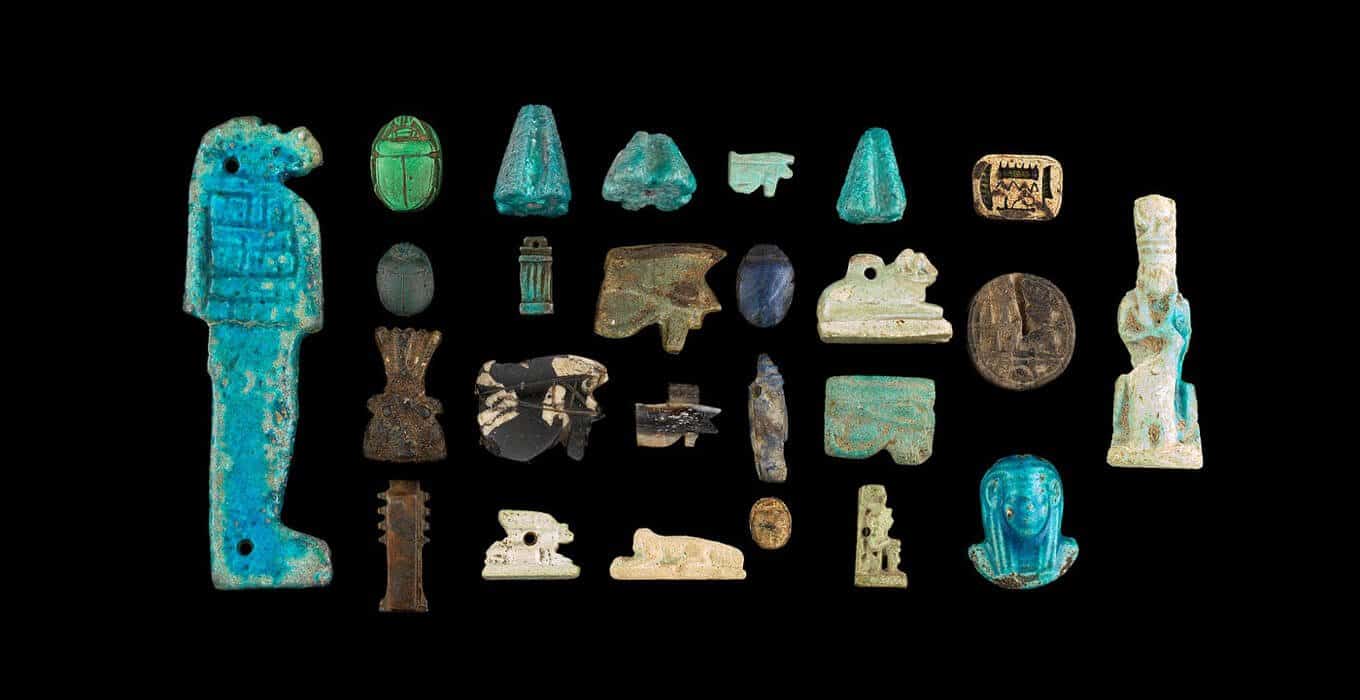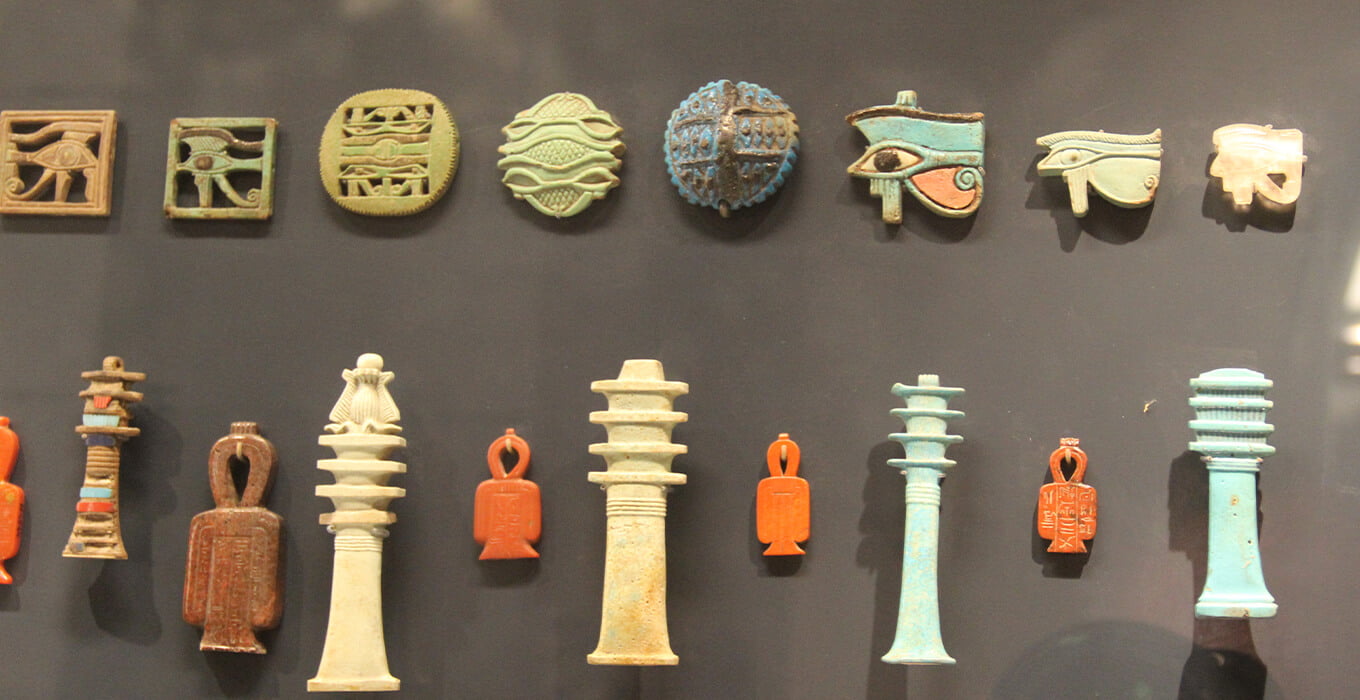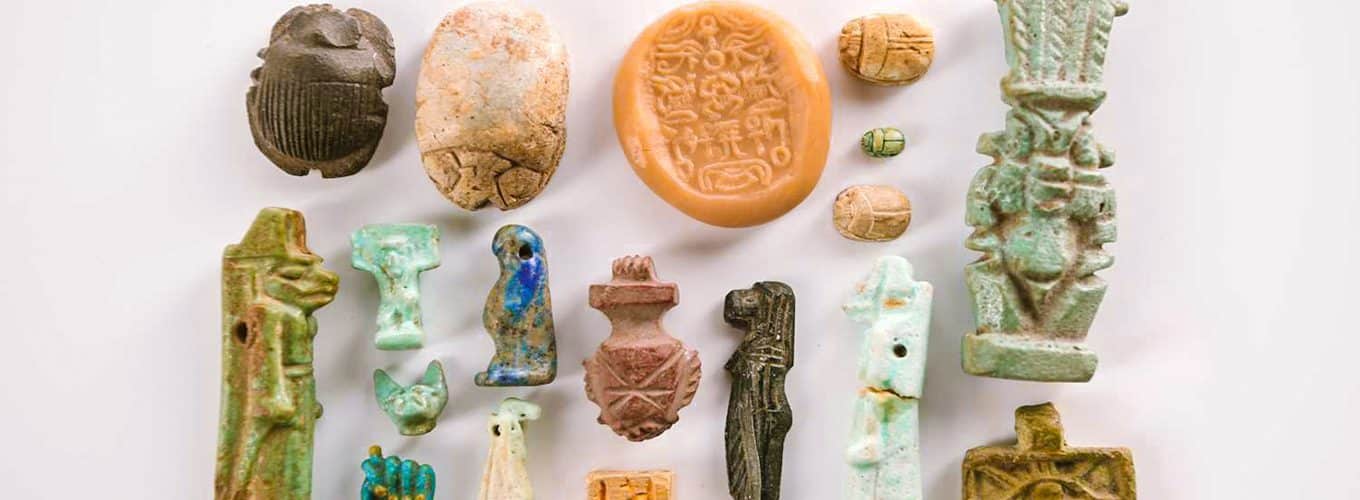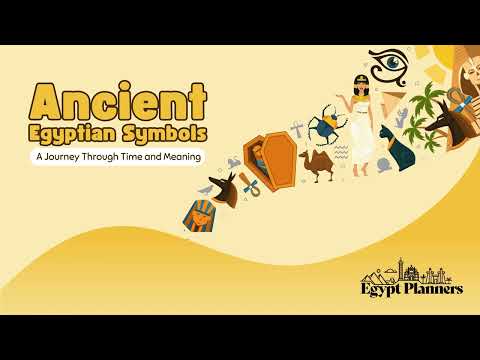Step back in time to Egypt (the land of pharaohs), where spirituality intertwined with daily life, and discover the captivating world of Ancient Egyptian Amulets. These small, intricately crafted objects were not just decorative pieces; they were believed to hold immense power, capable of protecting their wearer, bestowing health, and even guiding souls in the afterlife.
But what secrets do these amulets hold, and why did the ancient Egyptians so revere them? In this article, we will explore the origins, meanings, and symbolism behind some of the most famous amulets from this remarkable civilization.
Whether you’re passionate about history or simply intrigued by ancient mysticism, uncovering the mysteries of these powerful talismans will leave you spellbound.
Exploring Ancient Egypt with our Ancient Egypt Tours
Ancient Egyptian Amulets and Their Meaning for Powers
1- Egyptian Ankh Amulet
It was believed that the Ankh, shaped like a cross with a loop at the top, represented both life and immortality. Because it can rejuvenate, it provides the person who wears it with protection against malevolent powers and the assurance of a successful and long-lasting life. These ancient Egyptian amulets, known as Ankh, served as a physical connection to the never-ending circle of life.
2- Egyptian Scarab Beetle Amulet
Within the civilization of ancient Egypt, the Scarab Beetle was considered a powerful amulet. The scarab beetle amulet, which was fashioned as the holy dung beetle, was a sign of protection, enormous power, change, and rejuvenation in all ancient Egyptian cultures. By harnessing its lasting power for the benefit of the wearer, it was thought that it could ward against evil, bring good fortune, and assure a successful voyage into the afterlife. It was worn as a powerful charm, and it was believed to do all these things.
3- Djed Pillar Amulet
The Djed Pillar amulets were able to embody solidity and durability due to its shape, which was similar to a column with crossbars. Osiris, the deity of the afterlife, was inextricably related to it to a significant degree. The power of unshakable strength and protection was conferred upon the person who carried this amulet, particularly in respect to the world beyond.
4- Eye Of Ra Amulet ( Udjat Eye )
Udjat amults, also known as the Eye of Ra, were believed to represent the all-encompassing might of the sun deity. It was via the wearing of this amulet that the protecting gaze of Ra was summoned, so ensuring that malevolence was kept at bay. The continual alertness and safety that it represented was a symbol.
5- Winged Sun Amulet
One of the most prominent symbols in ancient Egypt, the Winged Sun was a representation of divinity with protection. It was believed that depicting a sun disk with the wings of a falcon or bird spread outward was a representation of the sun deity Ra’s watchful presence and guidance. Life, enlightenment, and a secure passage into the afterlife were all represented by this emblem, which was often seen on tombs and temples.
Ancient Egyptian Amulets of Protection

6- Eye of Horus Amulet (Wadjet Eye )
Eye of Horus amulets, also known as Wadjet Eye amulets, were made to resemble the eye of a falcon and were believed to provide protection in ancient Egypt. These amulets were believed to symbolize the watchful eye of the deity Horus. This amulet’s design, which has a characteristic teardrop form under the eye, is meant to represent the healing and regenerating qualities that this god possesses.
It is also capable of warding off the “evil eye” and bestowing blessings of health and energy, which are both examples of its defensive powers. It was thought that the Eye of Horus amulet would provide clarity and insight into the person who wore it, assisting them in navigating the problems that life presents.
7- Shen Ring Amulet
An amulet known as the Shen Ring is a circular symbol that does not have a beginning or an end. It is a representation of eternity and protection from all sides. It was thought that this amulet, which was often worn as a necklace, would encompass the person who wore it with the never-ending cycle of life and death.
The objective of it was to guard against injury, to fend off disease, and to assure a safe voyage in the afterlife. Because it embodies the idea of heavenly protection, the Shen Ring amulet is an essential charm for both those who are still alive and those who have passed on.
8- The Tyet (Knot of Isis) Amulet
The amulet created by Tyet, often referred to as the Knot of Isis, is a powerful representation of life, rebirth, and the protection of mothers. It is a symbol of the maternal and protecting powers of the goddess Isis, and it is designed to seem like an intricately knotted sash.
It was believed that the Tyet amulet, which was worn as a potent talisman, protected women during childbirth and ensured that they delivered safely. Additionally, it was connected to the concept of resurrection, which represented the unending cycle of life and death that was central to the Egyptian religious system.
9- Serpent Amulet
An amulet known as the serpent, which was often depicted as a snake that was coiled, was considered to be a sign of protection against poisonous animals and bad spirits. In ancient Egypt, snakes were considered to have a dual meaning, since they signified both danger and protection at the same time.
10- Bes Amulet
The image of the god Bes, a dwarf deity who is famed for his protective and pleasant attitude, is featured on the amulet known as the Bes. In ancient times, Bes was revered as the protector of homes, safeguarding their security and protecting them from malevolent forces.
Bes amulets were believed to provide happiness, laughter, and protection to the lives of those who wore them. These amulets were worn by both adults and children. A charming quality was given to its protective capabilities by the fact that it had a one-of-a-kind and often humorous look.
Learn about the best packages you can book with Egypt Planners and get a special discount
- 7 Day Cairo With Nile Cruise Tour Package
- 8 Days Cairo With 3 Nights Nile Cruise By Flight
- 8 Days Cairo And 4 Nights Cruise With Abu Simbel By Flight
- 10 Day Cairo, Alexandria And Nile Cruise With Abu Simbel By Flight
- 11 Day Cairo & Nile Cruise And Hurghada
- 14 Day Cairo & Alexandria & Nile Cruise And Hurghada
Ancient Egyptian Amulets of Gods, Goddesses, and Sacred Animals
11- Amulet of God Anubis
The jackal-headed deity of mummification and the afterlife, Anubis, was immensely revered in ancient Egypt. He was also known as the god of the afterlife. The protecting and guiding qualities that he had were represented in his amulet, which was often made with great detail. The power of this amulet was such that it could follow souls on their trip to the realm of the dead, assuring that they would arrive safely and receive heavenly instruction along the way. During the long voyage through the afterlife, it acted as a calming presence, bringing peace and protection to those who had passed away.
12- Bastet Amulet
As a captivating amulet, Bastet, the feline goddess of home, fertility, and protection, was revered and honored. It is a sign of her ferocious and protective personality, as well as her maternal and nurturing attributes, that this gorgeous item represents. The amulet of Bastet was worn in order to evoke her favors, which led to the establishment of a peaceful home and provided protection from danger. Since of its potential to bring wealth and protect against hardship, the Bastet goddess amulet was highly prized since it was considered to be the protector of the home and the hearth.
13- Egyptian Amulets Of Crocodile
It was believed that the deity Sobek was related to the crocodile, which was a powerful and adored monster in ancient Egypt. A crocodile-headed god of fertility and protection, Sobek was venerated for his power and guardianship. He was also known as the “God of Protection.” The protective attributes of Sobek were realized in the form of Egyptian amulets that were made in the appearance of crocodiles. In ancient times, people thought that these amulets might bring stability and protection against both physical and spiritual threats. Crocodile amulets were especially prized by those who lived near the Nile, where the crocodile was a powerful symbol of protection and plenty. Crocodiles were considered to be protectors of rivers and fertility.
14- Apis Bull God Amulet
Ancient Egyptians held the god of the Apis Bull in high esteem because he represented fertility and power. The Egyptians thought that it was a living divinity that existed on Earth. It was distinguished by a black and white coat and a symbol of divine strength. Apis was a deity in Egyptian culture that was revered for generations and was believed to symbolize the cycle of life, death, and reproduction.
Ancient Egyptian Amulets of Assimilation of Assimilation
15- Ancient Egyptian Wine Jars Amulet
During the time of ancient Egypt, wine jars were necessary containers for the storage and transportation of wine, which was a highly prized beverage that was often connected with rites and festivals. The significance of wine in Egyptian culture was shown by these wine jars, crafted from clay or porcelain and delicately decorated with elaborate hieroglyphics and symbols.
These jars seal the wine to preserve its taste and purity tightly. The wine was often produced from grapes cultivated along the Nile stream’s fertile banks. The complex tapestry of Egyptian history is revealed via these antique wine jars, providing a fascinating view of the nation’s past. In ancient Egypt, wine was important in everyday life and sacred events.
Ancient Egyptian Amulets for the Afterlife

16- Ba Amulet
The ba is a part of a person’s soul that represents their unique personality and traits. The ba-bird amulet represents this part of the soul. This charm let the ba easily move between the world of the living and the world of the dead. This made sure that the dead could stay true to themselves and be with their loved ones in the endless kingdom.
17- Shabti Figurine Amulet
The Shabti Figurine Amulet represented the idea of a shabti, which is are magical servant figure that is buried with the dead. The dead hired these figurines to do work for them in the future. The amulet represented these hardworking people, making sure that the dead would be helped and not have to work too hard in the afterlife.
18- Heart Amulet
The Heart charm, often written with magic from the Book of the Dead, could protect your heart during the judgment in the future. It ensured the pure and righteous heart would make a good decision in the Hall of Ma’at, which meant a peaceful journey forever.
Iconic Amulets of Ancient Egypt
19-Egyptian Canopic Jar Amulet
The Canopic Jar Amulet, an embalming jar, was a small version of the canopic jars used to mummify bodies. The important parts taken out during mummification were kept safe in these jars for the future. The charm the dead often wore was a sign of a guardian who would keep the organs intact and whole in the next world. Owl-shaped canopic jars were not common in ancient Egypt. The jars were usually made of different materials, like clay, limestone, or marble, and they were painted with many different symbols and hieroglyphs.
20- Two-Finger Amulet
This charm shows two sculpted fingers that are about the same size. The dead only wore amulets on their left fingers on the bottom left corner. During mummification, this area was cut open to remove the internal parts. This is where the cut was made. These amulets could heal wounds with magic. In the 26th Dynasty, this kind of charm was first made. They liked working with obsidian and other black stones. Sometimes you could find gilded charms, as the faint marks on this one show.
21- Headrest Amulet
The Egyptian Headrest Amulet was key to their Amulets of Funerary and Mummification. This detailed charm was very helpful for the dead because it held their head comfortably so they could sleep forever without being woken up. Laden, who had protection powers, watched over the soul on its eternal trip and ensured there was future peace.
22- Egyptian Heart Scarab Amulet
In ancient Egyptian funeral customs, the Egyptian Heart Scarab, a holy charm, was very important. It was made to look like a scarab bug and put on the chest of the dead to protect their heart on the way to the afterlife. It was written with magic from the Book of the Dead and ensured a fair trial in the Hall of Ma’at. This meant that the soul would live forever.
Ancient Egyptian Amulets for Fertility and Birth
23- Taweret Amulet
The Taweret Amulet had a picture of the goddess Taweret on it. She had the body of a pregnant hippopotamus and the arms of a lion. Taweret looked out for pregnant women and represented the caring and protective parts of being a mother. Wearing this charm called for her protection and blessings, making sure that the pregnancy went smoothly and the birth was safe.
24- Shell Amulet
In ancient Egypt, amulets made of cowrie shells were very important. These small shells with lots of different patterns were a sign of fertility and wealth. People often wore them as amulets to bring luck and protection, and the fact that they came from the sea linked them to the secrets of creation and the promise of growth.
25- Lotus Amulet
The Lotus Amulet was based on the lotus flower, which stands for cleanliness and new life. Lotus flowers were often used to decorate pictures of gods linked to birth and creation. People thought wearing this charm would help the soul’s trip into the physical world and ensure a safe and happy birth.
Ancient Egyptian Amulets for Health and Well-being
26- Menat Amulet
A very well-made amulet called the Menat holds the spirit of Hathor, the Egyptian goddess of music and fertility. When you wear this charm, Hathor’s gifts come to you and protect you. It grants you a real link to the spiritual world and promotes health by connecting you to the holy.
27- Egyptian Frog Amulet
The Egyptian Frog Amulet, also called a heqet, is a sign of fertility and renewal. In terms of health, it was thought to help with both physical and mental renewal. People believed that wearing this charm would bring in the forces of growth and renewal, making them feel healthy and full of life.
Ancient Egyptian Amulets and Their Meaning of Royalty
28- Hekha and Nekhakha Amulet
The Hekha and Nekhakha amulets, which were royal Egyptian symbols, were very important. The control and power of pharaohs were shown by these beautiful objects, which were often made in the shape of crossed scepters. People thought that these carefully made amulets would protect kings and make sure their reigns were safe and successful.
29- Uraeus Amulets (The Egyptian Cobra)
The uraeus or Wadjet cobra was a sign of the guardian snake goddess, who was one of Egypt’s first gods. Often, the uraeus was worn on top of a royal headdress, like the crown or the Pharaoh’s wreath. It stood for the Pharaoh’s power and divine protection. Those who were against the Pharaoh also thought it could spit fire at them. The gold Golden Uraeus of Senusret II and many other pharaohs have also been shown with it.
Ancient Egyptian Amulets for Health and Well-being
30- Menat Amulet
A very well-made amulet called the Menat holds the spirit of Hathor, the Egyptian goddess of music and fertility. When you wear this charm, Hathor’s gifts come to you and protect you. It grants you a real link to the spiritual world and promotes health by connecting you to the holy.
31- Egyptian Frog Amulet
The Egyptian Frog Amulet, also called a heqet, is a sign of fertility and renewal. In terms of health, it was thought to help with both physical and mental renewal. People believed that wearing this charm would bring in the forces of growth and renewal, making them feel healthy and full of life.
Ancient Egyptian Amulets of Royalty
32- Hekha and Nekhakha Amulets
The Hekha and Nekhakha amulets, which were royal Egyptian symbols, were very important. The control and power of pharaohs were shown by these beautiful objects, which were often made in the shape of crossed scepters. People thought that these carefully made amulets would protect kings and make sure their reigns were safe and successful.
33- Uraeus Amulets (The Egyptian Cobra)
The uraeus or Wadjet cobra was a sign of the guardian snake goddess, who was one of Egypt’s first gods. Often, the uraeus was worn on top of a royal headdress, like the crown or the Pharaoh’s wreath. It stood for the Pharaoh’s power and divine protection. Those who were against the Pharaoh also thought it could spit fire at them. The gold Golden Uraeus of Senusret II and many other pharaohs have also been shown with it.
Amulets in Ancient Egypt for Luck
34- Cartouche Amulets
In ancient Egypt, people loved cartouche amulets because of their unique oval shape. They were thought to bring good luck. The names of pharaohs were written in hieroglyphics on these beautiful objects, which were meant to protect and bless the person who wore them. The Egyptians thought that having a cartouche amulet could bring them luck, happiness, and protection from harm. They saw it as a valuable lucky charm.
35- The Ouroboros Amulets
In ancient Egyptian society, the Ouroboros, a snake or dragon eating its own tail, stood for endless circles and new life. Egyptians thought it brought happiness and safety and that it represented how life, death, and rebirth happen in a cycle. People often linked this strong symbol to the sun god Ra. It represented the continuity and favor of divine forces and brought hope and good luck to those who worshiped it.
36- The Sistrum Ancient Egyptian Amulet
In ancient Egypt, sistra amulets were very important. These small, holy instruments were shaped like a musical rattle. They had a handle and crossbars with loose rings that made a buzzing sound when they were shaken. Egyptians thought that the sistrum’s musical tones could protect and cleanse them, driving away bad spirits and bringing them the gifts of Hathor, their goddess of music, dance, and happiness. Sistrum amulets were worn or carried as a way to bring luck, happiness, and heavenly safety into one’s life.
Other Famous Amulets Ancient Egypt
37- Tutankhamun’s Amulets
Step into the opulent world of Tutankhamun, the boy king of ancient Egypt, and discover the amulets that adorned his burial chamber. These sacred charms, meticulously crafted and placed with reverence, held profound significance in guiding the young pharaoh through the afterlife. Join us as we unveil the stories behind Tutankhamun’s amulets, offering insights into the beliefs and rituals that surrounded this iconic ruler.
38- Min Amulet
Delve into the realm of fertility and abundance with the Min amulet, an ancient Egyptian charm dedicated to the god of fertility, Min. Explore the symbolism behind this intricate talisman and its role in invoking blessings for a prosperous life. From its artistic depictions to its ceremonial significance, journey with us as we unravel the mysteries surrounding the Min amulet.
39- Hathor Amulet
Enter the divine domain of Hathor, the goddess of love, music, and motherhood, through the lens of her sacred amulet. Discover how the Hathor amulet symbolized protection and invoked the nurturing qualities of the divine feminine. As we explore the intricate details of this enchanting charm, let’s uncover the cultural and spiritual context that made Hathor a revered figure in ancient Egyptian mythology.
40- Thoth Amulet
Unlock the secrets of wisdom and intellect with the Thoth amulet, dedicated to the god of writing and knowledge. Journey through the symbolic representation of Thoth and his significance in ancient Egyptian culture. Join us as we decipher the intricate details of this amulet, shedding light on its role in seeking divine guidance and safeguarding the pursuit of knowledge.
41- Wedjat eye Amulet
Peer into the protective gaze of the Wedjat Eye amulet, an ancient symbol associated with healing and warding off evil. Unearth the stories woven around this potent charm, exploring its connections to the goddesses and deities who watched over the living and the deceased alike. Join us in decoding the symbolism behind the Wedjat Eye and its timeless significance in Egyptian spirituality.
42- Nephthys Amulet
Embark on a journey to the realms beyond with the Nephthys amulet, dedicated to the goddess of the dead and the afterlife. Explore the role of Nephthys as a protective force and guide to the departed souls. As we unravel the mysteries of this amulet, delve into the profound beliefs that shaped the ancient Egyptians’ understanding of the transition from life to eternity.
Don’t miss out on our related:
- Top 30 Important Ancient Egyptian Symbols
- Eye of Horus vs Eye of Ra
- Anubis Egyptian Dog God
- Egyptian Symbols of Protection
- Egyptian Pharaohs
- Top 5 Egyptian Symbols for Power
- Top 8 Egyptian Symbols for Strength
- Top 15 Ancient Egyptian Good Luck Symbols
- Revered Animals in Ancient Egypt NYT
- List of Egyptian Queen Names
- Egyptian Scarab Beetle Symbol Meaning
- Ancient Egyptian Goddess Bastet


